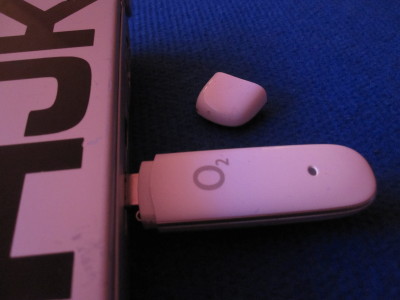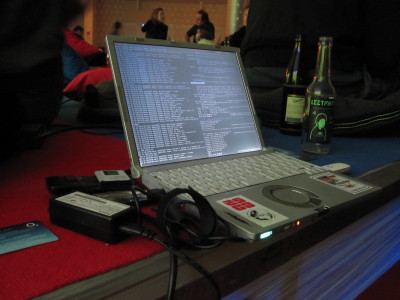28.12.2010 1:35, pesco
So, now I know how to make these USB UMTS stick thingies work…
I've been meaning to get one for a while,
so I got a cheap SIM-locked stick with a prepaid plan
for this year's post-christmas gadget shopping.
I'm recording how I got it to work as much for my own sake
as anyone else's…
For FreeBSD, you need the
u3g driver.
My model is a HUAWEI E1750,
which is one of several supported by the driver.
Here's what
dmesg shows:
ugen3.2: <vendor 0x12d1> at usbus3
ugen3.2: <vendor 0x12d1> at usbus3 (disconnected)
ugen3.2: <HUAWEI Technology> at usbus3
u3g0: <HUAWEI Technology HUAWEI Mobile, class 0/0,
rev 2.00/0.00, addr 2> on usbus3
u3g0: Found 4 ports.
Note the
4 ports
message.
These things act like an old modem,
presenting a virtual serial port on which they accept
AT
commands.
Just like old times.
Actually, they often present several ports serving
different functions.
$ ls /dev/cuaU?.?
/dev/cuaU0.0 /dev/cuaU0.1 /dev/cuaU0.2 /dev/cuaU0.3
You have to find the one to use by experimentation.
I learned that
screen can actually be used as a terminal emulator
for this (instead of the clunky old
minicom):
$ screen /dev/cuaU0.0
Type
AT and see if you get an
OK reply.
Most sticks also present mass storage devices.
There is usually an emulated
CD
drive that contains
driver software for Windows and MacOS.
Some models appearently require this
disk
to be
ejected
before even switching on the modem part.
I'm not sure if mine does;
the
u3g manpage states that it should happen
transparently (look for
u3gstub
).
This model also has a microSD slot that can be used
like any regular usb storage device.
cd0 at umass-sim0 bus 0 scbus0 target 0 lun 0
cd0: <HUAWEI Mass Storage 2.31> Removable CD-ROM SCSI-2 device
[...]
da0 at umass-sim1 bus 1 scbus1 target 0 lun 0
da0: <HUAWEI SD Storage 2.31> Removable Direct Access SCSI-2 device
Since the SIM card is usually protected by a PIN,
one needs to enter this before it will perform its function.
These and other UMTS-specific functions are simply accessed by
special AT commands.
Many have a
query
variant ending in a question mark that will
report the current status and a
set
function with an equals sign.
> AT+CPIN?
+CPIN: SIM PIN
OK
> AT+CPIN=1234
OK
> AT+CPIN?
+CPIN: READY
OK
If you don't care about feedback,
the PIN entry can be done by writing directly to the device file.
$ echo "AT+CPIN=1234" > /dev/cuaU0.0
My device now signals its ready status by blinking its LED in
a different color and rhythm.
Now for the PPP connection (just like old times!),
in
/etc/ppp/ppp.conf:
o2:
set log Phase Chat LCP IPCP CCP tun command +connect
set device /dev/cuaU0.0
set speed 460800
set dial "ABORT BUSY ABORT NO\\sCARRIER ABORT ERROR TIMEOUT 5 \
\"\" \
AT OK-AT-OK \
AT+CFUN=1 OK-AT-OK \
AT+CSQ OK \
AT+CGDCONT=1,\\\"IP\\\",\\\"internet\\\" OK \
AT+CGACT? OK \
AT+CGATT? OK \
ATD*99***1# CONNECT"
set timeout 180 # 3 minute idle timer (the default)
set ifaddr 10.0.0.1/0 10.0.0.2/0 255.255.255.0 0.0.0.0
set vj slotcomp off
set crtscts on
add default HISADDR # set default route
enable dns # set dns servers in resolv.conf
There is a bunch of stuff in there I just copied from examples
on the web. Let's see:
set log Phase Chat LCP IPCP CCP tun command +connect
This makes
ppp write all kinds of stuff to syslog (
/var/log/ppp.log).
Very useful if something goes wrong, but completely optional.
The keywords after
set log
select different parts of the whole
exchange and can be left out individually if desired.
set speed 460800
No idea if this is necessary.
All kinds of
baud rates
seem to just work.
set dial "ABORT BUSY ABORT NO\\sCARRIER ABORT ERROR ...
The
dial
setting is the conversation script
ppp follows
in order to set off the right sequence of AT commands that
open the connection.
This is actually executed by chat(8).
See that manpage for the syntax.
The first line sets abort conditions.
If the modem responds with
BUSY
,
NO CARRIER
or
ERROR
to any command,
ppp will consider the connection attempt failed.
AT OK-AT-OK
This one uses a
subexpect/subresponse pair
(-AT-OK) and
just makes sure that the modem responds (two tries).
AT+CFUN=1 OK-AT-OK
This command turns the device
on
if it
doesn't do it automatically.
Not sure what
on
means exactly,
maybe that it actually goes on the air looking for its network.
My device does this automatically
after entering the PIN.
(I think that's what the changed LED pattern actually means.)
Anyway, the command just becomes a no-op
when it is issued again.
AT+CSQ OK
This asks for the signal strength.
Not really necessary,
but maybe it fails if there is absolutely no signal.
AT+CGDCONT=1,\\\"IP\\\",\\\"internet\\\" OK
This is somewhat important.
It sets the
APN
.
I'm actually not sure what that is,
but I'm guessing some kind of logical access point
that the mobile network operator can define.
It's just called
internet
in my case,
you have to set the right one for your network.
The Web has lists of these.
Google for
umts apn setting
.
Actually, the command sets a bundle of parameters known
as a
PDP context
.
There can be many of these,
identified by numbers,
and the modem can be switched around among them.
AT+CGACT? OK
Asks the modem which of the above-mentioned contexts
is active.
Not sure why this is necessary or useful,
copied it from an example.
AT+CGATT? OK
Asks the modem whether it is attached to the GPRS service.
Presumably this can fail.
ATD*99***1# CONNECT
Finally, this is the
dial
command that opens the PPP
connection.
The number 99 seems to be standard.
The part
***1
is optional and specifies the PDP context to
use.
BTW, I'm guessing the ATD command can also be used to dial
the magic numbers used for activating prepaid time on the card.
Will have to try this later.
Enough AT commands, back to
ppp settings:
set ifaddr 10.0.0.1/0 10.0.0.2/0 255.255.255.0 0.0.0.0
This is another important one.
I didn't look it up in the docs,
but one thing it accomplishes is explicitly setting the
point-to-point address on the network interface.
Appearently the necessity of this depends on the setup
of the peer, i.e. some supply their own address, some don't.
Mine didn't and I always got this in the log:
tun0: Warning: iface add: ioctl(SIOCAIFADDR, 10.150.178.217
-> 0.0.0.0): Destination address required
tun0: Error: ipcp_InterfaceUp: unable to set ip address
The last two interesting ones are these:
add default HISADDR # set default route
enable dns # set dns servers in resolv.conf
And that's basically it. Now
$ ppp -ddial o2
will establish the connection,
disappear into the background,
and keep it open until killed.
There are a few other modes besides
ddial,
consult the manpage.
Interesting links:

